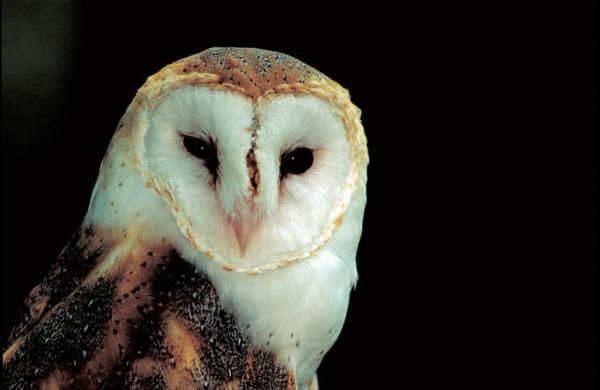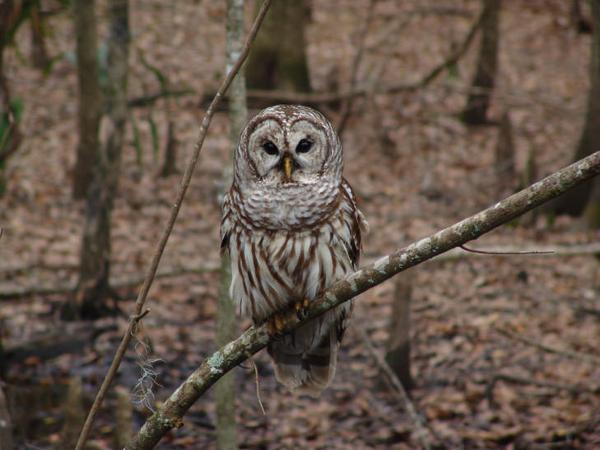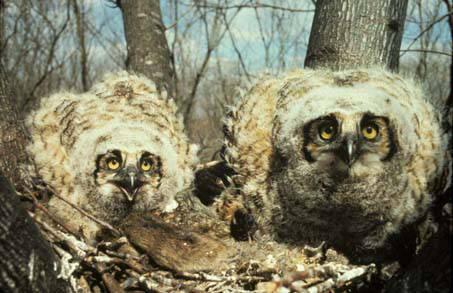Introduction
Owls are birds of prey that primarily are active during the night and during twilight hours. Often mysterious to man, owls figure largely in myths, folklore and superstition. Much like hawks, owls prey on rodents, reptiles and other small animals, including invertebrates. Specific prey include crayfish, mice, snakes, lizards, birds, rabbits, and the occasional fish. Typically solitary feeders, owls may occasionally gather in winter roosts or at an abundant food source.
Owl Adaptations
- Large retinas - Vision is 50-100 times better than humans in poor light
- Many rods - High concentrations of rods in eyes (light-gathering cells)
- Binocular vision - Fixed eyes view the same scene from slightly different angles - improving depth perception
- Large head with wide ear spacing - Disk-like design receives sound at minute thresholds; large ear openings and asymmetric ear positions improve hearing
- Stealth feathers - Leading wing feathers have soft-serrated edges for noiseless flight
- Regurgitation - Owls absorb nutritious foods through stomach walls but regurgitate “pellets” of indigestible hairs, feathers, bones, and claws
Habitat
Owls are found across North Carolina. Owls are largely forest birds with most requiring cavities in dead or hollow trees or dense vegetation to seek refuge during the day. Habitat requirements vary among owl species, so it is important to consider the food and cover requirements of each species when developing a habitat management plan.
| Great-Horned Owl | Barn Owl | Barred Owl | Screech Owl |
| Habitat | |||
| Open forests, fallow fields, and shrubland; Benefits from openings and clearings. Nests in old crow, heron, or hawk nests. |
Abandoned fields, pastures, and marsh areas; Benefits from openings and nest boxes. Nests in man-made structures: silos, barns, and buildings. |
Mature hardwood floodplain forests; Benefits from long hardwood rotations and snag retention. Nests in hollow trees, often over water. |
Forest, often densely stocked; Nests in hollow trees, abandoned woodpecker cavities. |
| Food | |||
| Rabbits, woodrats, mice, grouse, squirrels, and other birds | Voles, rats, and mice | Snakes, frogs, turtles, small mammals, and occasional birds | Mice, snakes, frogs, insects, flying squirrels, chipmunks, and small birds |
| Description | |||
| length: 20 - 23 inches wingspan: 60 inches weight: 3.5 pounds |
length: 15 - 20 inches wingspan: 44 inches weight: 20 - 24 ounces |
length: 20 inches wingspan: 44 inches weight: 2 pounds |
length: 10 inches wingspan: 22 inches weight: 6 - 7 ounces |
| Prominent ear tufts; brown plumage above, mottled with grayish white; light gray underside with dark bars; a white band of feathers on the upper breast; rust colored face | Long-legged, light color with a heart-shaped face; (also known as “monkey-faced” owl) white or pale cinnamon belly with buff or rusty upper feathers | Rounded head, brown eyes; lacks ear tufts; gray-brown plumage with white spots on the back; whitish or grayish underparts barred with buff or deep brown | Small owl with ear tufts; it exhibits two color phases: gray and red; chestnut red during red phase, brownish-gray during gray phase; pale breast and belly are streaked with dark gray or chestnut |
Owl Management
General
- Create a diversity of stand ages intermixed with openings.
- Create and maintain early successional vegetation using prescribed fire, herbicides, disking, and to a lesser extent bush hogging.
- Maintain larger tracts of forest. Most species of owl use forests for roosting, nesting, and foraging.
- Maintain and create snags in large diameter trees, typically at least 10“ in diameter at chest height.
- Manage bottomland hardwoods in large blocks and long harvest rotations of at least 80 years.
Direct Improvements
- Erect nest boxes for cavity-nesting owl species (Figure 1). Detailed plans for building owl nesting boxes can be found from the Cornell Ornithology Lab’s All About Birdhouses.
- Construct brush piles to attract the rodents that owls eat.
- Thin forest to promote development of understory plants, which in turn provide habitat for many prey species eaten by owls.
| Species | Cavity Floor* (inches) | Cavity Side (inches) | Entrance Above Floor (inches) | Entrance Hole Size (inches) |
| Barn owl | 11 x 223⁄4 | 123⁄8 x 16 | 4 | 33⁄4 x 41⁄2 |
| Screech owl | 10 x 113⁄4 | 10 x 16 | 111⁄2 | 3 |
| Barred owl | 111⁄2 x 13 | 13 x 23 | 12 | 7 |
| * add 2 inches to floor dimension for roof | ||||
Working With Wildlife
North Carolina State University Extension - Forestry
Working With Wildlife Series
Publication date: July 1, 2019
Reviewed/Revised: May 28, 2024
N.C. Cooperative Extension prohibits discrimination and harassment regardless of age, color, disability, family and marital status, gender identity, national origin, political beliefs, race, religion, sex (including pregnancy), sexual orientation and veteran status.
N.C. Cooperative Extension prohibits discrimination and harassment regardless of age, color, disability, family and marital status, gender identity, national origin, political beliefs, race, religion, sex (including pregnancy), sexual orientation and veteran status.




